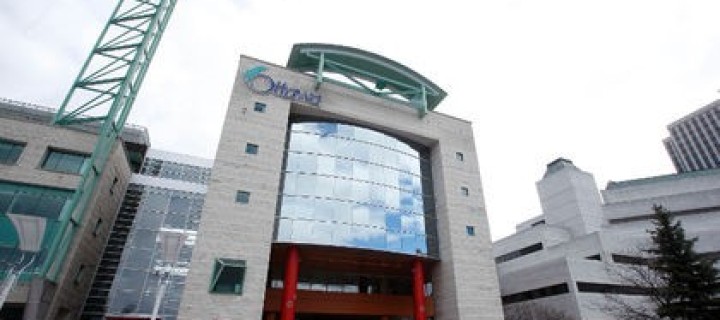Ottawa City Hall photographed Thursday, Mar. 28, 2013. Darren Brown/Ottawa Sun/QMI Agency.
Update 10th September, 2016
City of Ottawa seems bent on hosing down its rate-supported services with new storm water fees, while tax-supported operating budgets are dripping in deficits.
The problem is the CITY is having a hard time getting its service principles, costing and billing algorithms right. The fact of the matter is budgets are merely goals, while levies of taxes and fees are not necessarily congruent with the services actually received, or short changed for that matter.
Snow jobs, rainfalls, shortfalls and windfalls mess with CITY budgets, expenditures and taxpayers’ reserve funds. Meanwhile other levels of government, federally and provincially, try to impose their will on municipalities with deficit equity programs to conserve and measure nature’s bounties in the name of science.
The bottom line is the city runs deficits in most all its programs and services. Meanwhile unpredictable weather patterns in the name of global warming and climate change provide the rationale to fix up “crumbling infrastructures” that have served us well for over a hundred years.
Another “rationale” is the mad scramble for more money, a slate of “shovel-ready projects” at the same time in the competition for sustainable development, conservation schemes and climate change pipe dreams.
All the while some consider that new, sponsored, subsidized “GLOBAL” technologies and carbon taxes necessary, must be applied and ramped up to create economic growth and to save the planet. There is no measurement for this type of ideological overhead, but it abounds.
Of course there is also another more realistic/practical take for public consumption. We are spending more on tax-supported services than we bring in from tax revenues. Salaries and benefits admittedly drive the budget. The city ended 2015 with a deficit of $42 million. Some would argue that is pretty small potatoes or pretty good budgeting on a $3 billion dollar corporation.
The City had forecasted a $46.5 million deficit when it tabled its 2016 budget. Arguably any forecast could just have easily been suitable. However, when the actual deficit came in at $42 million the deviation of $4.5 million was rationalized as a positive and attributable to a freeze on hiring and discretionary spending.
Snow jobs aside, all that to say the higher the forecasted deficit, the higher the voodoo savings. The real question is what happens when the freezes are lifted.
On the property tax revenue-supported side of the City Budget, $25.9 million of the overall actual $42 million deficit was attributed to costly winter maintenance jobs combined with millions of additional dollars needed for arbitration awards and increased Safety and Insurance Board charges.
Within the $25.9 million, $13 million occurred on the tax supported side in the first three months of 2015 according to the Auditor General, City Audit November 27th 2015. The overall budget for winter maintenance approximated $60 million.
In short, that is either a budget shortfall of $13 million, attributable to arbitration awards, safety and insurance charges or an out and out unsustainable 22% operating deficit. Mother Nature, lower standards and/or gas prices had nothing to do with that over-expenditure, even though the City claimed $2.7 million in savings resulting from internal efficiencies.
In general, a review of previous budgets expenditures at the line object level shows that deviations up and down are quite normal no matter the service. The aggregate position is unlikely to go downwards when tax revenues are predetermined on a fixed rate of increase.
It is still necessary presumably to accommodate growth, development and improvement in core service, political overtones aside. In part, fees for service have become a growing and integral part of the City’s revenue-generating policy on both tax and rate-supported services.
The fact of the matter is the OC Transpo’s year-end deficit was $11.6 million. Police, fire, paramedics, public works and the library services also ended 2015 in the RED, according to a column by Matthew Pearson, Ottawa Citizen, February 24th 2016.
Separately, a further $15.9 million deficit occurred in managing water and sewer services paid for through utility rates, service fees and interest rate structures. This makes up the balance of the City’s overall $42 million deficit during 2015. The City had forecasted a $10 million deficit for these rate-supported services.
In short, besides a close to 60% forecasting error, a $15.9 million deficit is small potatoes when it comes to a $300-plus million water and sewer budget. As such it is a mere 5% operating loss in the aggregate. This over-expenditure occurred even though rate changes increases had been implemented for 2015.
The water rate and fire supply support had been raised by 6% and sewer surcharge was calculated at 117% of water usage.
According to the City these three charges were intended to provide the funds to transport clean potable water to our homes and to carry wastewater away from our homes for treatment and release into the Ottawa River.
The other purposes for these rate increases that gave legs to existential matters associated with protecting the environment, reducing the risk of flooding and renewing “existing” and rehabilitating infrastructure.
Extensive resource costs are included in the service rate in order to maintain and comply with imposed public health protection, provincial legislation, regulations and standards for Ottawa residents’ water, storm water and sewer services.
Added to the resource costs is a notion that environmental protection and economic development must be part of the delivery and recovery system. Rainfall and evaporation has served us for a million years.
Some infrastructure has served us for a hundred years. Besides, there are no specifications when it comes to storm water, impervious surfaces and or licences to charge fees for Mother Nature’s bounties on an accurate measurement of water used.
On the economic development front, water bills are based on a user-pay basis, which means the cost of the aggregate water and sewer services are based on the amount of water used. All other costs, though ill-defined, are apportioned within the revenue-generating rate.
The fact is, the economic development goals had more to do with Smart Meters, the more visible technology development solution geared to billing, collection and distributed processing between accounts. Accordingly, the system billing algorithms are incongruent with the realities required to manage the processes and use of water, sewer and storm water systems.
According to the City website, the purpose of the Smart Meters is to track water usage to ensure that customers are billed only for the water they use. To that end, it was intended or targeted to have every household, business and facility located within municipal boundaries equipped with a water meter.
The improvement cited was more accurate readings than using estimates, as had been the case previously. That improvement is still a work in progress and has not been achieved because there are more than 45,000 properties that run on self-financed and maintained well water and septic tank systems.
As such the use of radio frequency remotely transmitted water consumption information for individual accounts is a solution looking for a problem when it comes to “FAIR” and equitable billing. It has now been discovered that there is no correlation between water consumption and rainfall filling up storm sewers and culverts.
In short, some city residents have been charged for services they did not use, while some in the City now claim that some residents are receiving services they are not paying for. The City now wants to change the rate revenue structure.
There is no correlation or scientific evidence to differentiate between rainfall and storm water volumes falling, collecting or running on rural pervious fields versus impervious city surfaces.
The City introduced SMART METERS in 2011. Most cities in Ontario have a variety of experiences with Smart Meters. It is stated on the City website this was a city initiative and we did not have to pay for them.
Then who paid is an obvious question and who is accountable for the expenditures associated with meter conversion, the water meter implementation, integration and interface with other systems and their use with other technologies such as My Service Ottawa and at what cost?
No matter, at the end of 2015 lower-than-expected water consumption added $5.9 million to the deficit. As a result, the water, sewer and storm water “program” had been funded by water and sewer bills where the forecasts were based on previous budgets, expenditures, contingency requirements and rates of inflation, roughly speaking.
$1,114, 500 was budgeted for revenues related to interest charges and reminder fees on accounts receivable. The payment process is cumbersome. The logistics system has built-in delays associated with payment offices, outsourcing, and processing procedures.
It is claimed by the City that these services and interest rates are competitive with private industry. The City does not accept credit card payments.
Some fees associated with water and sewer payment, collections and default end up servicing the tax revenue account. For example, service charges on final notice billings are transferred to the tax account but not to the water account.
Furthermore who is paying for all the so called INVESTMENTS and RE-INVESTMENTS in the normal course of systems development and technology exploitation where systems life cycles are limited? Is it rate, tax or subscription supported?
For example, “My Service Ottawa” uses a web portal and online account enabler to view, print and pay property taxes, water and sewer bills as well as manage all e-subscriptions with the City all in one place. The website states:
This is only the beginning. More services will be made available.
Based on my enquiry concerning the purpose, forecasted budgets and costs, My Service Ottawa it seems is included as part of the overall annual operating budget supporting the KNOWLEDGE and WEB SERVICES Branch within the Services Ottawa DEPARTMENT.
Such is governed by another agenda whose information operations and disciplines are prescribed by provincial statutes, for security, accuracy and privacy of information, systems integrity and so on.
Getting down to brass tacks, there is sufficient evidence of incongruence and corporate overheads in the water, sewer, and storm sewer processes to conclude that the rationale for the use of Smart Meters has been lost in the systems applications that have evolved, since the decision was made to deploy and employ them. The purpose of the meter was to measure water consumption more accurately.
Meanwhile the task of managing aging infrastructure, a growing population, environmental concerns, increasing government regulations and rising costs are pressing concerns well beyond the scope of billings and portals.
City Council increased the tax levy by 2% or $72 per household and approved a water rate increase for 2016 among others. Water and sewer services rates have been increased by a further 6% or $49 annually in the face of lower declining usage in 2015.
That brings us to NEW DEVELOPMENTS of another kind; improvements to the city water and sewer services and the mitigation of a $42 million operational deficit.
The City had a $270.8 rate-supported capital program in 2015. According to the City Treasurer, $100 million comes from the GAS TAX and is being used to build light rail. The balance comes from other internal sources, including upper levels of government.
A forecasted amount has been earmarked for city rehabilitation and renewal programs such as maintaining equipment for operations, as well as the replacement of 15,000 outdated water meters. Fire hydrant maintenance is also included.
According to the City website, an integrated water & sewer program to renew and replace sanitary sewers and storm drains were considered to be projects underway.
For example it has been reported that it will cost $231.3 million to build a cross-town sewage tunnel to intercept overflows, millions more than the $195 million originally anticipated. This involves a funding formula in which three levels of government committed to contribute one third each over the life span of the project.
It has also been reported that officials from all three levels of government celebrated the joint funding agreement at the Robert O. Pickard Environmental Centre, the city’s sewage treatment facility on Shefford Road…and so on.
The City Treasurer has stated that the City’s reserves are healthy enough to deal with OR ABSORB the 2015 deficit of $42 MILLION. After doing so, reserves are expected to hit $267 million by the end of the year. (Jennifer McIntosh, Metroland, reports: City could dip into reserves to deal with 2015 deficit)
On top of that, according, to Sun column, 8th March 2016 by Jonathan Willing, “not enough money is coming into the coffers through water bills to pay for water, wastewater and stormwater programs.”
So, the column continues, the City needs to find a NEW METHOD to bill customers with which to feed the $316 million budget for these core services. The City proposes to have a fixed cost on each water bill where the amount would be based on the SIZE of the water meter. Meanwhile 45,000-47,000 homes are without Smart Meters because they have and maintain their own private wells and septic systems.
Apart from raiding the reserves of $42 million to cover the 2015 city operating deficit, the City wants to change the revenue structure so as to charge for precipitation running into storm sewers and ditches.
This coincidently is estimated at $42 million for 2016 even though there isn’t an evident correlation to the amount of water consumed, whether it enters the storm sewers or not. The fact is the proposed budget for water and sewer levies has already been increased by 6% for 2016 anyway.
While we have heard from the Treasurer that city reserves are healthy and his Worship the Mayor has stated “We have reserves for the reason that we can’t always budget precisely,” an $8.6 million deficit can be identified and attributed to water and sewer deficits.
The city estimates that $8 million of the overall $42 million deficit is spent on storm water services in rural areas and they seek Council approval to apply additional levies on rural residents. In the absence of criteria and billing algorithms, this is an unfair tax grab on services not necessarily rendered and a matter of principle.
The fact of the matter is that the bulk of the remaining operating deficits, $33.4 million occurred in snow-clearing expenses, OC Transpo maintenance costs and revenue deficits, characterized as “unforeseen aspects of recent overspending.” The matter of principle is unclear when it comes to the eligibility to raid CITY Reserves earmarked for renewal and rehabilitation programs.
The problem is two-fold: Ontario is buried by MASSIVE DEBT. (Ottawa Sun, March 14th 2016 by Ben Eisen, Associate Director and Charles Lammam, Director of Fiscal Studies, Frazer Institute).
Two-thirds of the increase in provincial government debt since the recession is due to annual operating deficits – spending on government operations over revenues.
The second referring to the Auditor General Report on City of Ottawa Snow Clearing was the observation that (Public Works) does not have a documented process to identify potential operational efficiencies to realize cost reductions.
Furthermore, information on staff allocation by activity is not presently considered, analyzed or included in the PLANNING PROCESS to identify potential operational changes or efficiencies.
Deficits are really mortgages on the future and can hardly be blamed on climate change or the consequential crumbling of under-maintained City infrastructure or renewal and rehabilitation programs.
Perhaps, it is time to do a program evaluation of the objectives, needs, effectiveness and costs and benefits of the Smart Water Meters and Presto Magic-Transpo measuring and monitoring systems and processes.
In matters water and sewer, residents are being charged for services they do not receive. Residents subscribe to tax and rate-supported services funded by all level of government. City staff plan to do an inventory of the City’s reserves and report back at the end of 2016.
This is a cart before the horse scenario, a built in imbalance in providing efficient and effective “SERVICE” and CONTROLLING the taxpayer and funding subsequently.
It is fair to say that CITY services are in disarray, lack budget transparency, forecasting accuracy and effective instruments of cost recovery based on usage at the budget and operational level.
Kevin Murray is a Professional Administrator, Certified Systems Professional and Licensed Plumber.
Related UpFront Ottawa Article: No Discretion, Latitude or Recourse when it comes to City Sewage Charges: Kevin Murray, November 13th 2015.
References- Accreditations:
Jonathan Willing-PostMedia: Ottawa Sun, November 13th 2015-City Vows BUDGET “efficiencies” won’t impact front line services.
Jonathan Willing-Ottawa Citizen, 24th February 2016- City ends 2015 $42 million in the hole.
Hugh Adami. The Public Citizen, Ottawa Citizen March 5th 2016- $6.60 water bill reminder fee called downright insulting.
Jonathan Willing-Post media: Ottawa Sun, 8th March 2016,-Ottawa wants new water bill setup.
Jonathan Willing-Ottawa Citizen, 11th March 2016-Storm Water fee would fund rural projects.
Jonathan Willing-Ottawa Citizen, 16th March 2016- Thompson says storm water charge on rural land “does not make sense.”
Kelly Egan-Ottawa Citizen 16th March 2016- A Novel Cost-Saving Idea for the Snow of March-Let it Melt.
Update, March 20: Anthony Furey has done our article credit in his Ottawa Sun article “Rural residents getting hosed.” As Furey writes, “Nickel-and-diming certain segments of society is the drip-drip-drip of an insidious tax grab – and council’s been caught red-handed.”
Kelly Egan’s article “Absurdities of city’s taxes and fees are giving the public good a bad name.” Egan adeptly writes how the “search for alternative revenue never ends,” and argues: “[…] it’s all a little backward sounding: we pay massive amounts of property taxes for things that are intangible or little used, only to be charged a special ‘fee’ for work that sounds so basic, like ditch digging.”
Update, April 13:
Ottawa Sun 13th April 2016 , comment Column: Presto! More tax money gone.
The funding plans for the Ottawa Light Rail Construction Project depends on gas tax money allocated by the Ontario Government. An annual amount of $34 million for a work already very much in progress is at stake, not to mention the impact on transit ridership disruptions and feed in tariffs associated with the transfer of funding.
Funding is based on contractual conditions in the Ontario Government’s agency created by its own Ministry of Transport – known as METROLINX – that receives 2% commissions per passenger ride and use of its smart card transaction services on the City of Ottawa’s transit systems. The City of Ottawa pays for the meters.
The article makes a very solid case for a no “strings attached exchange” of the committed gas tax money as a more efficient and effective way of transferring the funding to the City of Ottawa rather than having the City’s Transport Services consider whether Metrolinx’s operations are cost-effective or seeking increased commissions for its operations and profitability.
In the face of the City’s own $11 million deficit and budgetary service risks, Metrolinx, an AGENCY, is a fare collection service for the City and its transit passengers, not the other way around. The transport system subsidized by City taxes and the ridership are one and the same – TAX PAYERS for the Transit system, the gasoline tax and the core transit service subsidized in part through property taxes.
Update, April 15:
Reference to Ottawa Sun, 15th April 2016, Council Seeks “Nuance” in Rain Tax. Jon Willing, Ottawa City Hall Bureau
The City is having second thoughts on imposing a “RAIN TAX” to pay for storm Water SERVICES. The Chair of the Council’s Agricultural and Rural Affairs Committee said Residents have challenged the City to come up with more alternatives, while the Chair of the ENVIRONMENTAL committee said the City is looking at a more ”NUANCED-APPROACH” as a result of feedback from eight public meetings. The City has delayed recommendations for a month and now wants a NEW WATER and SEWER RATE STRUCTURE by the start of Fiscal Year 2017.
Nepean-Barrhaven News: Article by Kelly Kent- Metrolandmedia April 14th, Rural residents push back
The City Collects fees for stormwater and have done so since amalgamation through the Water and Sewer Rate System. According to the City presentation, the “BUDGET” for that is $42 .4 millions. The City wants all residents to fork out for these services claiming that rural residents receive a “BUDGETED” $8.4 million dollars of services that they are not paying for. Rural residents are claiming they do not receive them and in the main take care of their own water sewer and stormwater maintenance and needs.
The City claims their services are $8.4 million and have been working since May 2015 to develop options to recover the BUDGET/Costed storm management amounts more fairly among all City of OTTAWA Residents – to sort of apply a flat rate for COST RECOVERY.
First of all these are budget cost estimates. The City ran an $42 million deficit in the aggregate. It would be helpful if the City could make clear whether the $ 8.4 million is part of that deficit or not-given that it has been providing storm-water services anyway since amalgamation, without any apparent shortfalls. Is this a genuine cost increase for the services or a tax grab?
The City claims they have already been providing for ditch maintenance services in the amount of $2 million dollars-the Rural residents claim otherwise as they do it. An amount of $1 million is also claimed for pond and erosion maintenance.
The real rub is the claim for $5.4 million for $4.5 million of CAPITAL CONTRIBUTIONS and close to another $1 million for technical and management support. Maybe the city could explain how many more ponds and erosions occur and whether they have increased due to an increase in storm water or a lack of maintenance, perhaps even CLIMATE CHANGE. In other words, the NUANCED fees may well rest in the justification for BUDGETED versus ACTUAL COST INCREASES.
Ottawa Sun, 10th September 2016- Think-Tank touts stormwater fees. Jon Willing.
An Ottawa university think tank called SUSTAINABLE PROSPERITY calls on Cities to adopt separate fees so that property owners know exactly how much they are paying for stormwater infrastructure. The report was released Monday Sept 11th 2016 to coincide with the LIVEABLE CITIES FORUM in Halifax Nova Scotia. Basing a stormwater fee on PROPERTY VALUES or WATER CONSUMPTION IS NOT FAIR since they have no relation to how much storm water is CAUSED BY THE PROPERTY.
The best method is to charge each property for the amount of stormwater services it uses, the report says. The City of Ottawa has considered a property-specific fee but is worried about the cost of assessing each property-The city came up with options to implement a stormwater charge either based on property value asessments, property types or simply through a one size-fits all fee but an outcry from residents sent staff back to the drawing board in Spring OF 2016.
One might ask: did it really take a UNIVERSITY think tank to establish the obvious. Storm water is a variable and the CITY systems have not been maintained in a sustainable manner even though maintenance charges have been collected and paid for through the water account for YEARS. The money evaporated just like 80% of rainfall does naturally. Have pity on our farmers for goodness sake!







